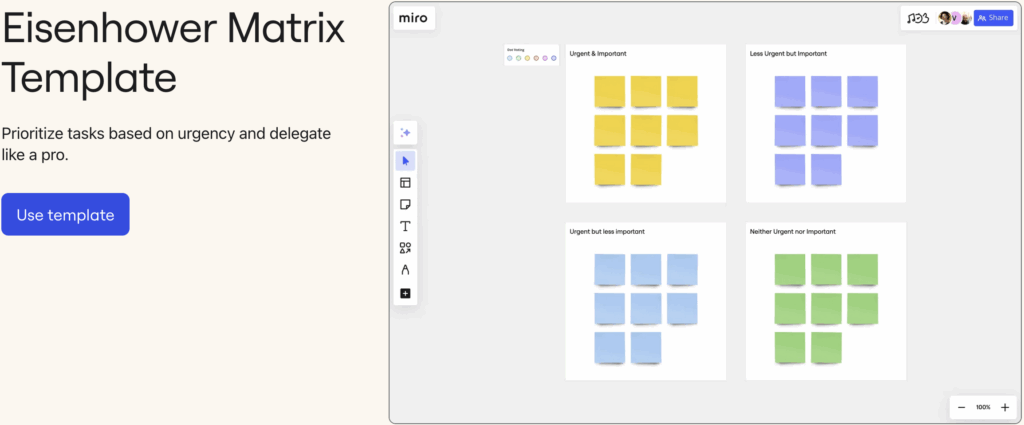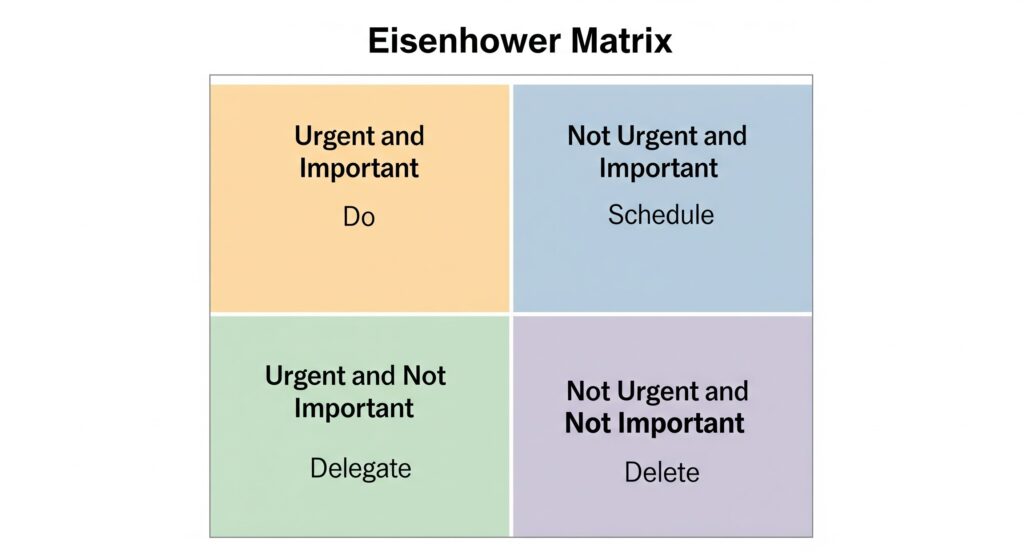In today’s fast-paced and often chaotic environments (VUCA – Volatility, Uncertainty, Complexity, Ambiguity), effectively managing your time and prioritizing tasks is crucial for success. The Eisenhower Matrix, also known as the Urgent-Important Matrix, is a powerful tool to help you do just that. It was reportedly used by Dwight D. Eisenhower, the 34th President of the United States, and is based on his strategy quote: “What is important is seldom urgent and what is urgent is seldom important.”
I first encountered this “Urgent-Important Matrix” in Steven Covey’s 7 Habits of Highly Effective People Book. It has stuck with me since and a tool I like to share with people when they are overwhelmed with competing priorities and long to-do lists.
This guide will walk you through the Eisenhower Matrix and how to apply it to your work and life.
Understanding the Eisenhower Time Management Matrix
The Eisenhower Matrix divides your tasks into four quadrants based on two criteria: Urgency and Importance.
- Urgent: Requires immediate attention. Often associated with deadlines, crises, and immediate needs.
- Important: Contributes to your long-term goals, values, and mission. Helps you achieve significant outcomes.
Here’s a breakdown of the four quadrants:
Let’s explore each quadrant in detail:
Quadrant 1: Urgent and Important (Do)
- Description: These are critical tasks that demand immediate attention. They often involve crises, pressing problems, and deadline-driven projects.
- Examples:
- Dealing with a critical client issue.
- Meeting a tight deadline for a major project.
- Responding to a serious emergency.
- Action: Do these tasks immediately. These are your top priorities.
Quadrant 2: Not Urgent and Important (Schedule)
- Description: These tasks are crucial for achieving your long-term goals but don’t require immediate action. They often involve planning, prevention, relationship building, learning, and strategic thinking.
- Examples:
- Strategic planning and goal setting.
- Building relationships and networking.
- Professional development and learning new skills.
- Preventative maintenance and system improvements.
- Exercise and self-care.
- Action: Schedule time in your calendar to do these tasks. Proactive work in this quadrant prevents tasks from becoming urgent.
Quadrant 3: Urgent and Not Important (Delegate)
- Description: These tasks demand immediate attention but don’t contribute significantly to your long-term goals. They are often interruptions, meetings requested by others, or tasks that others can handle.
- Examples:
- Answering non-essential emails or phone calls.
- Attending meetings that don’t require your direct input.
- Minor administrative tasks that can be delegated.
- Requests from others that don’t align with your priorities.
- Action: Delegate these tasks to others if possible. If you can’t delegate, try to minimize or postpone them. Saying “no” to these tasks is often necessary to protect your time for more important activities.
Quadrant 4: Not Urgent and Not Important (Eliminate / Delete)
- Description: These tasks are neither urgent nor important. They are often time-wasters, distractions, and activities that provide little to no value.
- Examples:
- Excessive social media browsing.
- Watching too much television.
- Engaging in unproductive gossip.
- Trivial tasks that don’t contribute to your goals.
- Action: Eliminate these tasks from your schedule altogether. Be ruthless in cutting out activities that don’t serve you.
How to Use the Eisenhower Matrix
- Brainstorm Your Tasks: Make a comprehensive list of all the tasks you need to accomplish, both personally and professionally.
- Evaluate Each Task: For each task, ask yourself two questions:
- Is it urgent? (Does it require immediate attention?)
- Is it important? (Does it contribute to my long-term goals and values?)
- Categorize Your Tasks: Place each task into the appropriate quadrant of the Eisenhower Matrix.
- Take Action Based on the Quadrant:
- Quadrant 1 (Urgent & Important): Do it Now.
- Quadrant 2 (Not Urgent & Important): Schedule it.
- Quadrant 3 (Urgent & Not Important): Delegate it.
- Quadrant 4 (Not Urgent & Not Important): Eliminate it.
- Review and Adjust Regularly: Your priorities may change over time. Regularly review your task list and the Eisenhower Matrix to ensure you are focusing on what truly matters.
Benefits of Using the Eisenhower Matrix
- Improved Prioritization: Helps you clearly distinguish between urgent and important tasks, allowing you to focus on what truly matters.
- Increased Productivity: By eliminating time-wasting activities and delegating appropriately, you can significantly boost your productivity.
- Reduced Stress: By proactively planning important tasks and dealing with urgent matters efficiently, you can feel more in control and reduce feelings of overwhelm.
- Better Decision-Making: Provides a framework for making conscious decisions about how to allocate your time and energy.
- Alignment with Goals: Ensures that you are dedicating time to activities that contribute to your long-term objectives.
Tips for Effective Use
- Be Honest in Your Assessment: Accurately evaluate the urgency and importance of each task. Avoid labeling everything as “urgent” or “important.”
- Protect Your “Schedule” Time: Treat scheduled tasks in Quadrant 2 as firm appointments. This is where you invest in your future success.
- Get Comfortable with Delegation: Learning to delegate effectively is crucial for managing Quadrant 3 tasks.
- Be Ruthless with Elimination: Don’t be afraid to say “no” to tasks that fall into Quadrant 4.
- Focus on Quadrant 2: Spending more time on important, non-urgent tasks can prevent them from becoming urgent and critical (Quadrant 1).
I like to use realtime collaborative whiteboard tools like Miro or Mural. Here’s a Miro Eisenhower Matrix Template.

Eisenhower Time Management Matrix: Prioritize and Strategize Amidst Change
By understanding and consistently applying the Eisenhower Time Management Matrix, you can take control of your time, prioritize effectively, and achieve your most important goals, even in the face of a volatile and uncertain world.
Please contact us if you are interested in a workshop on this topic.
